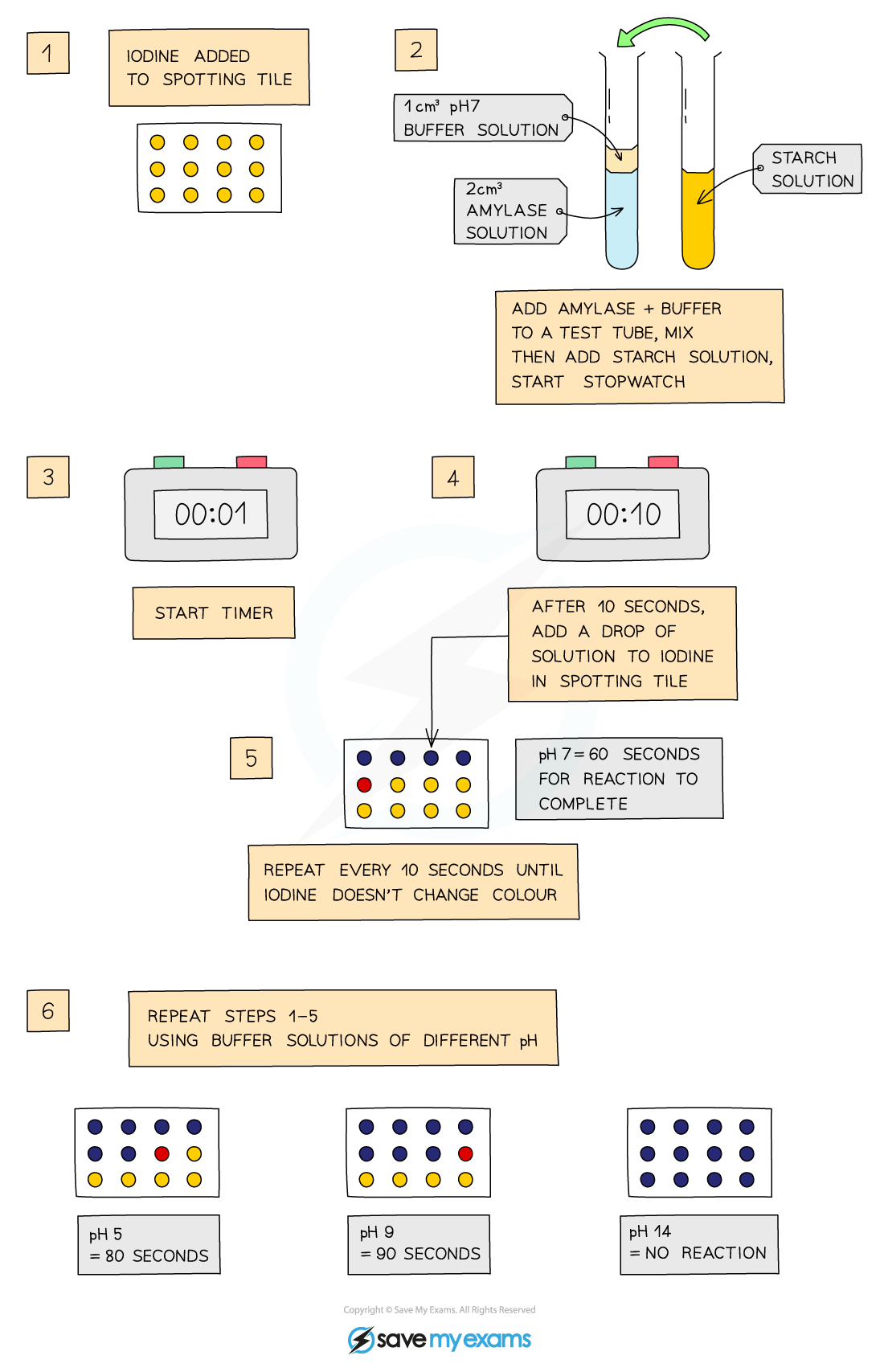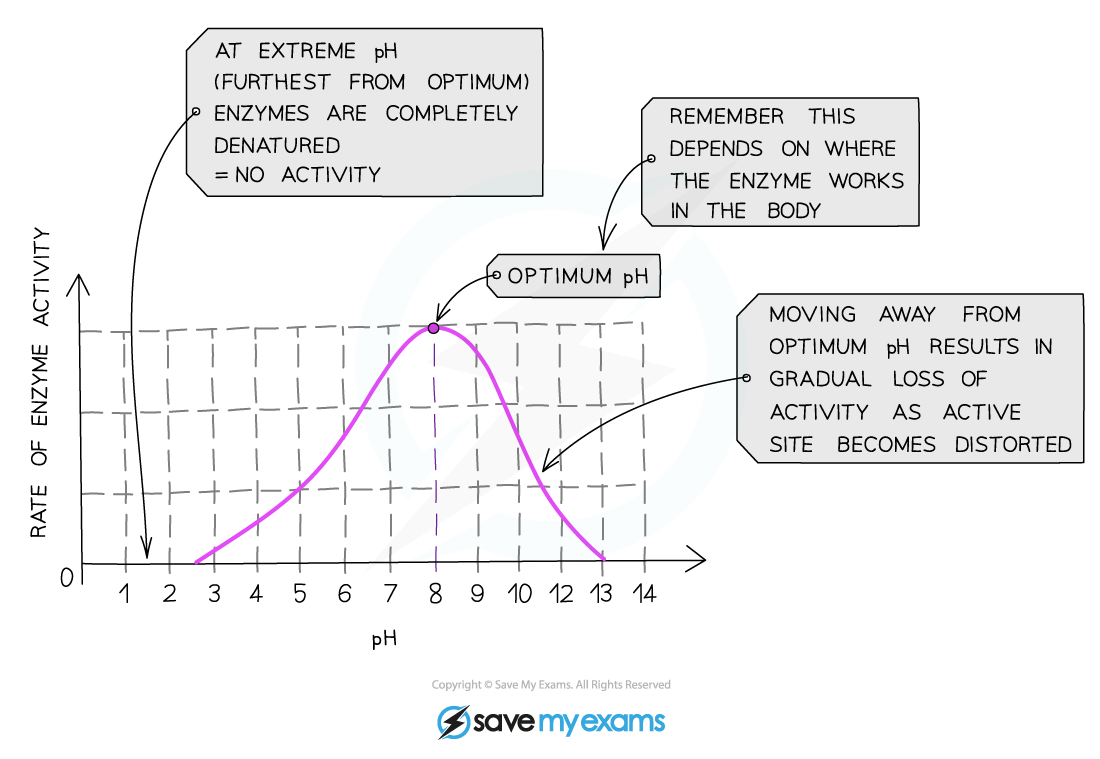Enzyme Experiments
Enzymes & pH
- Amylase is an enzyme that digests starch (a polysaccharide of glucose) into maltose (a disaccharide of glucose)
- The effect of different pH levels on the activity of amylase can be investigated
Apparatus
- Spotting tile
- Measuring cylinder
- Test Tube
- Syringe
- Pipette
- Stopwatch
- Buffer solutions
- Iodine
- Starch solution
- Amylase solution
Method
- Add a drop of iodine to each of the wells of a spotting tile
- Use a syringe to place 2 cm3 of amylase into a test tube
- Add 1cm3 of buffer solution (at pH 2) to the test tube using a syringe
- Use another test tube to add 2 cm3 of starch solution to the amylase and buffer solution, start the stopwatch whilst mixing using a pipette
- Every 10 seconds, transfer a droplet of the solution to a new well of iodine solution (which should turn blue-black)
- Repeat this transfer process every 10 seconds until the iodine solution stops turning blue-black (this means the amylase has broken down all the starch)
- Record the time taken for the reaction to be completed
- Repeat the investigation with buffers at different pH values (ranging from pH 3.0 to pH 7.0)

Investigating the effect of pH on enzyme activity
Results and analysis
- Amylase is an enzyme that breaks down starch
- When the iodine solution remains orange-brown, all the starch has been digested
- This investigation shows:
- At the optimum pH, the iodine stopped turning blue-black and remained orange-brown within the shortest amount of time
- This is because the enzyme is working at its fastest rate and has digested all the starch
- At the optimum pH, the iodine stopped turning blue-black and remained orange-brown within the shortest amount of time
- At higher or lower pH's (above or below the optimum) the iodine took a longer time to stop turning blue-black or continued to turn blue-black for the entire investigation
- This is because on either side of the optimum pH, the enzymes are starting to become denatured and as a result are unable to bind with the starch or break it down
Limitations
- The starch and amylase solutions that need to be used should be placed in a water bath at optimum temperature before being used
- A colorimeter can be used to measure the progress of the reaction more accurately by measuring the absorbance/transmission of light through the coloured solution
- A control of iodine solution would be used for comparison

A graph showing the optimum pH for an enzyme from a region of the small intestine
Enzymes & temperature
- The effect of different temperatures on the activity of amylase can be investigated
Apparatus
- Spotting tile
- Measuring cylinder
- Test Tube
- Syringe
- Pipette
- Stopwatch
- Iodine
- Starch solution
- Amylase solution
- Water bath or heat source
Method
- Starch solution is heated to a set temperature Iodine is added to wells of a spotting tile
- Amylase is added to the starch solution and mixed well
- Every minute, droplets of solution are added to a new well of iodine solution
- This is continued until the iodine stops turning blue-black (this means there is no more starch left in the solution as the amylase has broken it all down)
- Time taken for the reaction to be completed is recorded
- The experiment is repeated at different temperatures (using a water bath or heat source)
- The quicker the reaction is completed, the faster the enzyme is working
 Investigating the effect of temperature on enzyme activity
Investigating the effect of temperature on enzyme activity
Limitations
- A buffer solution should be used to maintain a constant pH
- A colorimeter can be used to measure the progress of the reaction more accurately by measuring the absorbance/transmission of light through the coloured solution
- A control of iodine solution would be used for comparison
Results & analysis
- Increasing the temperature from 0⁰C to the optimum increases the activity of enzymes as the more energy the molecules have the faster they move and the number of collisions with the substrate molecules increases, leading to a faster rate of reaction
- This means that low temperatures do not denature enzymes, they just make them work more slowly

Graph showing the effect of temperature on the rate of enzyme activity
Calculating the rate of reaction
- Rate calculations are important in determining how fast an enzyme is working (i.e. the rate of reaction)
- To perform a rate calculation, use the following formula:
Rate = Change ÷ Time
- 'Change' refers to the change in the substance being measured
- This could be the amount of substrate used up in the reaction or the amount of product formed
- 'Time' refers to the time taken for that change to occur
- Another way to view the equation is as follows:
Rate = Amount of substrate used or product formed ÷ Time
Worked example
Amylase catalyses the breakdown of starch into maltose. 15 grams of starch were added to a solution containing amylase. It took 2 hours for all the starch to be broken down. Calculate the rate of reaction.
Step One: Write out the equation for calculating the rate of enzyme activity
Rate = Change ÷ Time
(In this case, Rate = Amount of substrate used ÷ Time)
Step Two: Substitute in the known values and calculate the rate
Rate = 15 g ÷ 2 hours
Rate = 7.5 g / hr or 7.5 g hr⁻¹
- In the example above, the 'change' was the amount of substrate (starch) that is used up in the reaction
- In the example below, the 'change' is the amount of product that is formed in the reaction
Worked example
The enzyme catalase catalyses the breakdown of hydrogen peroxide into water and oxygen. In one experiment, a student found that 45 cm³ of oxygen was released in 5 minutes. Calculate the rate of reaction.
Step One: Write out the equation for calculating the rate of enzyme activity
Rate = Change ÷ Time
(In this case, Rate = Amount of product formed ÷ Time)
Step Two: Substitute in the known values and calculate the rate
Rate = 45 cm³ ÷ 5 minutes
Rate = 9 cm³ / min or 9 cm³ min⁻¹
- Alternatively, you may not be told how much something has changed during a reaction (i.e. how much of a substrate has been used up or how much of a product has been formed)
- Instead, you may only be told the time taken for the reaction to occur
- In this case, you can still calculate the rate of reaction by using the following (slightly different) formula:
Rate = 1 ÷ Time
Worked example
A student adds a set volume of starch solution to a set volume of amylase solution at a range of different pH values. At each pH, the student times how long it takes for the amylase to break down all of the starch. At pH 6 the time taken for amylase to break down all of the starch was 50 seconds. Calculate the rate of reaction at pH 6.
Step One: Write out the equation for calculating the rate of enzyme activity
Rate = 1 ÷ Time
Step Two: Substitute in the known values and calculate the rate
Rate = 1 ÷ 50 seconds
Rate = 0.02 s⁻¹
Exam Tip
The units for the calculation above are in s⁻¹ because rate is given per unit time. In an exam, you could be asked to plot the reaction rates (from an enzyme catalysed reaction) on a graph. However, using the equation 'Rate = 1 ÷ Time' often gives small numbers that are difficult to plot on a graph. In these cases, you can also use the equation:
Rate = 1000 ÷ Time
This equation give you bigger numbers that are easier to plot on a graph. So, for the calculation in the worked example above, you would get:Rate = 1000 ÷ 50 secondsRate = 20 s⁻¹

